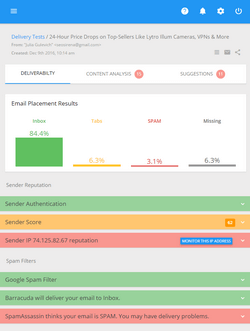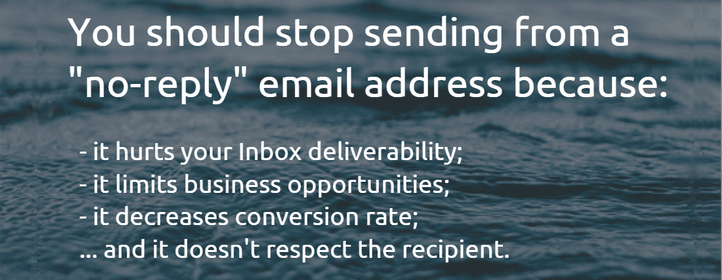7 Reasons Why You Should Not Send from a “No-Reply” Email Address
Despite best email marketing practices which teach marketers to send emails from their real email address, many marketers still send campaigns from a "no-reply" email address explaining their behavior by the fact that "the email contains nothing people would want to respond to" or "I don't want to foul my Inbox with auto-replies".
Even if that is true, when it comes to email marketing, there are no good excuses for sending from "no-reply" email addresses. Not only do you show your recipients that you don't care about what they think or want to ask you, "no-reply" email addresses also hurt your email reputation and deliverability.
So, here are 7 reasons why you should stop sending from a "no-reply" email address right now:
1. It Shows Your Bad Side
By not allowing the recipients to reply to your email campaigns, it makes you look like you don't care about your recipients. It's a one gate play when you can blast them with emails and they can do nothing. A "no-reply" email address means "We want you to hear from us, but we don't want to hear from you". By all means, you should not limit their ability to communicate with you.
2. It Hurts Your Inbox Deliverability
To protect their users from spam, many email services and ISPs rely on the recipient's engagement when they are sorting incoming emails by different folders. So whether or not a recipient opens, clicks, replies, forwards, unsubscribes, or deletes the email determines if the ISP considers the message as good or spam.
For example, Gmail ranks the importance of an email based on the recipient's opens and replies. If recipients reply to your emails, then Gmail is more likely to consider them to be important. It's reasonable to assume that Gmail applies the similar algorithm to determine whether an email should land in the Inbox or spam folder.
Some ISPs, network spam filters, and customers' personal email security settings are set up to move messages with "no-reply" addresses to the junk folder.
So, letting people reply to your emails is a good thing as it might help keep your message out of junk, bulk or spam folders, and increase the overall deliverability and conversion.
3. It Reduces Conversion Rate
Nobody likes messages from robots or machines. People like to think there's a real person at the other end of the email. With a "no-reply" email address, the message feels cold and impersonal and it makes the recipient less likely to take action on it.
4. It Increases Spam Complaints
Some people don't bother to search for the unsubscribe link in the email and hit "Reply" when they wish to unsubscribe. When they see that they cannot contact you via email, the first thing they can do it to simply hit the "Report Spam" button. Is that the kind of response you expect?
5. It Doesn't Allow You to Keep Fully Updated List
Sometimes people send a reply in an attempt to update their personal profile with you. They might have changed the email address or moved to a different company, so they reply the message and tell that they are no longer at their current address and want to update their contact data.
If you send from a "no-reply" email, you don't allow them to do that and you keep their old email address unless they update it through your data center on your site if it is available. Some will do it, some will not.
A real email address will help you find out valuable information in the replies that you can use to clean up your email list, which recipients no longer work for a company, for example. And excluding these addresses from your mailing list helps you increase your open rates and prevent you from hitting a spam trap.
If you don't want to bother looking auto-replies through, there are many tools that can be set up to monitor the mailbox and delete "out of office" emails automatically. For example, EasyMail7 can do that.
6. It Doesn't Allow the Recipient to Whitelist You
Asking the recipient to whitelist or add your sending email address to their address book is another way to ensure Inbox Delivery. Would you add a "no-reply" email address to your address book?
And most ISPs do not allow their users to add "no-reply" emails to their address books. If you are not in the address book, your emails are more than likely to be flagged as spam and sent to the junk folder.
7. It Limits Business Opportunities
People are used to being able to reply to emails to share their opinion, thoughts, suggestions, asking for help or compliment you on your work.
If you don't allow them to reply, you may miss a chance at a sale, feedback, testimonial, business proposal, referral or other important communication.
And last, but not the least…
A bonus tip:
Don’t use generic friendly “From” names like “Customer Service”, “Account Verification”, “Monday Newsletter”. Always include your brand name: “GlockApps Customer Service”, “GlockApps Account Verification”, “GlockApps Monday Newsletter”. A “From” name without your brand is automatically suspicious.
If you are still using a "no-reply" email address for your campaigns, you can test your Inbox placement with G-Lock Apps Inbox delivery testing service and see how different ISPs treat your message. Then test the same message with a real email address from your domain and branded “From” name and compare the results. I bet you'll see the difference.
Spam Testing for Marketers
 | Reach the inbox every time.Improve your delivery ratesImprove your deliverability by scanning your emails through all the major spam filters before you send. Get actionable tipsReceive a spam score as well as actionable tips for improving your delivery rates for every email send. Increase your revenueImprove your overall email performance by ensuring more emails are getting through to your subscribers. |



John
| #
I hate no reply emails and agree, particularly with points 1 and 7.
I’ve received several emails where I was ready to make a purchase, pending a question I had about the product. I reply and “ahhh”, its a no-reply. Those companies lost the sale.
I also feel that if I can send out mails I should expect to receive replies. Its my role as server admin to ensure that I protect my mailbox from spam. I have to do that with the technology available, not by putting a barrier up so that legit clients and potential clients can’t contact me. In other words, you might have to add an eighth point there:
8) It shows poor / lazy mail server admin!